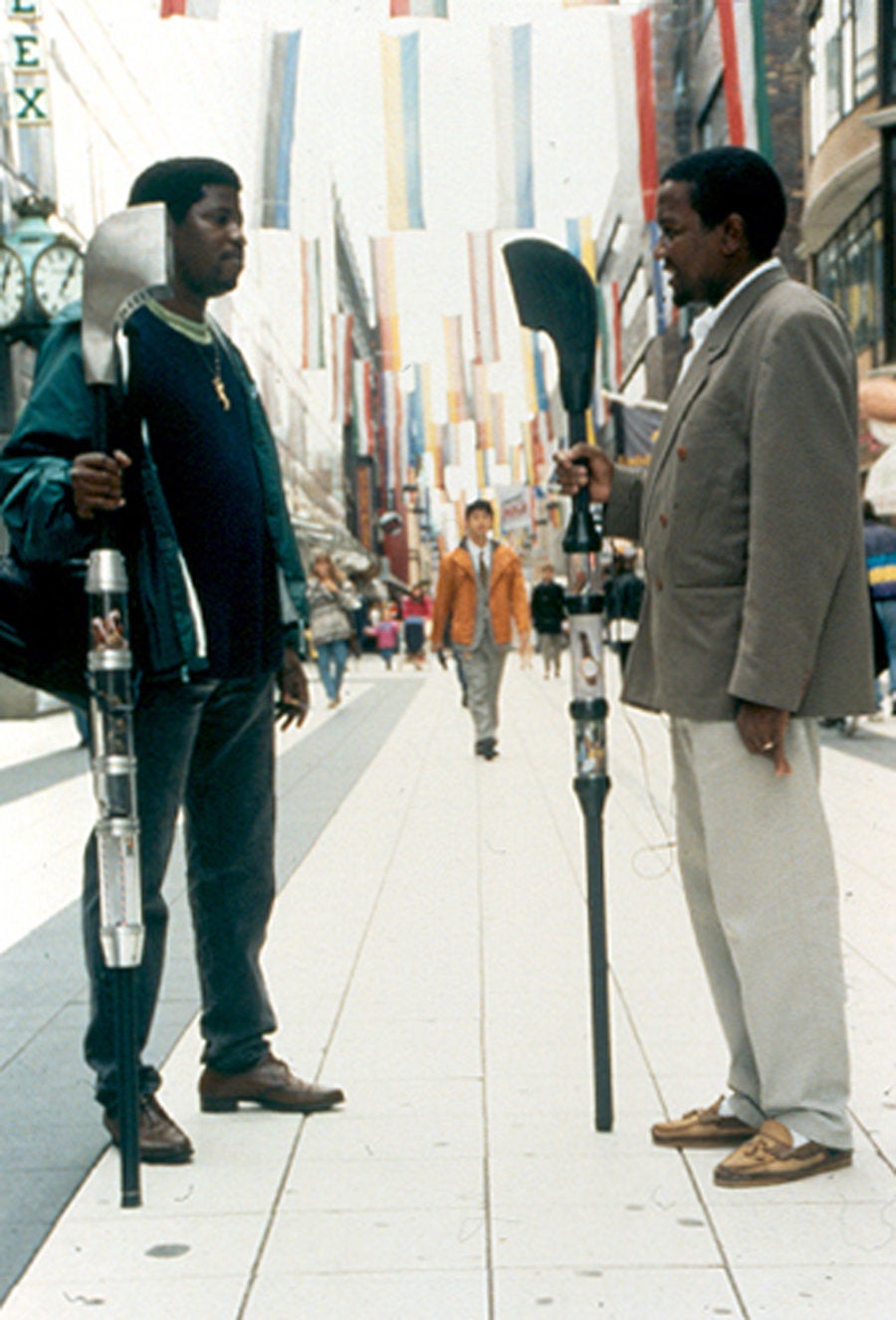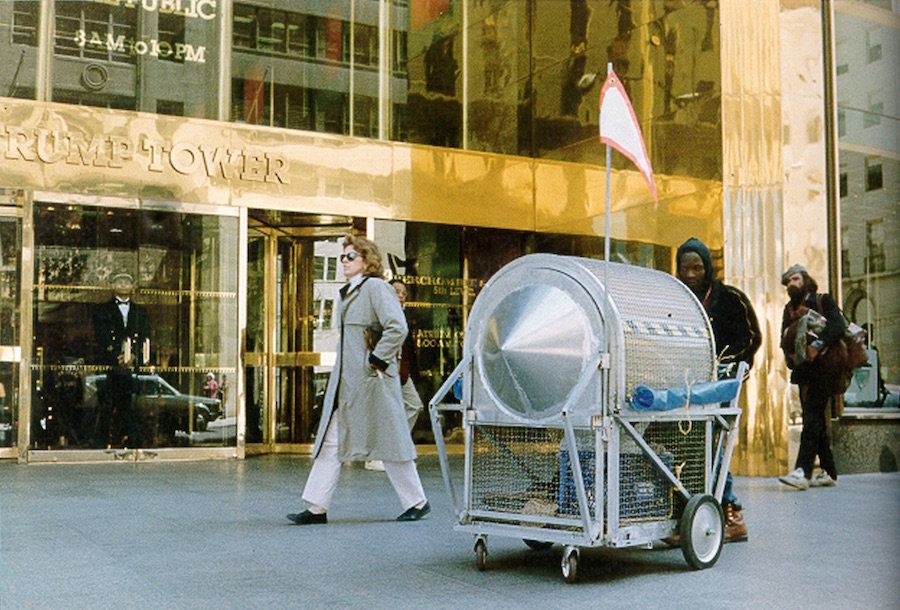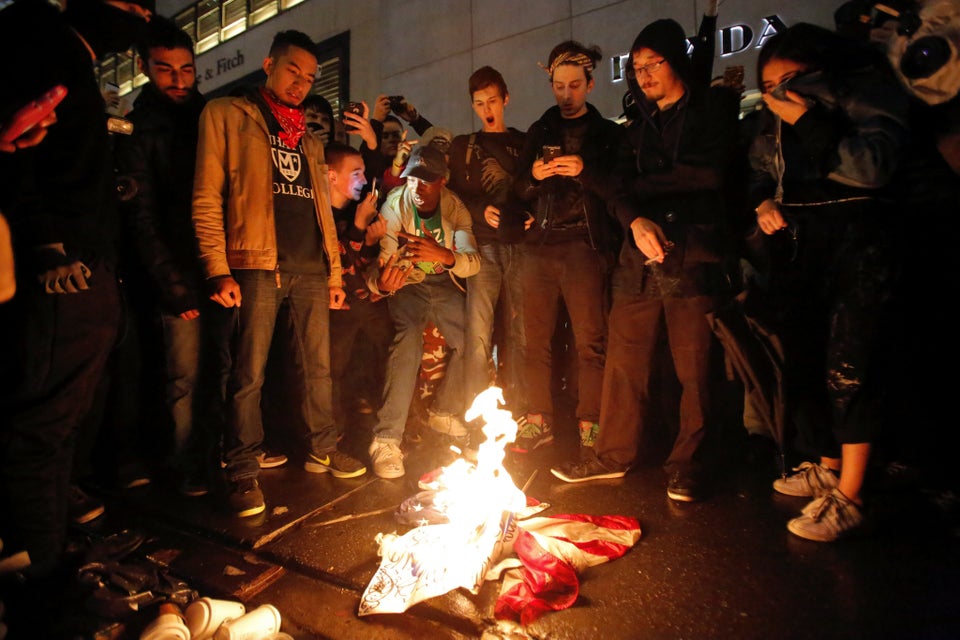“This is an important and calling time for artists,” Polish artist Krzysztof Wodiczko expressed in a statement.
This sentiment has been gaining traction around the nation as artists appalled with the results of the recent presidential election turn to art as a vehicle for communication, catharsis and resistance. However, Wodiczko did not write this statement in 2016. He wrote it in 1988, during the Ronald Reagan administration.
At that time, Wodiczko was using art to address the glaring wealth disparity plaguing New York City, evidenced by the tens of thousands of homeless individuals living in abandoned buildings and on city streets each night. Many of these individuals had been thrown out of mental hospitals and halfway houses because of federal subsidy cuts, Wodiczko says, or pushed out of low-income housing by burgeoning real estate moguls like ― yes ― Donald Trump.
“Trump was only one of a large number of real estate corporations that were basically owning Manhattan.”
- -Krzysztof Wodiczko
“Donald Trump was, at that time, part of an aggressive real estate development process,” Wodiczko, now a professor in residence at Harvard University who spends much of his time in the U.S., explained to The Huffington Post in a phone interview this week. “Very rapid, uneven development. With the building of new housing and real estate projects for upper-middle-class residents, there was also a process of destruction of the buildings where poor people lived. Trump was only one of a large number of real estate corporations that were basically owning Manhattan. But he was special because of the visibility and upfront decor which was appealing to those who are in love with richness.”
In response to the changing landscape of New York City in the late ‘80s, and the many people this rapid development left behind, Wodiczko created a series of “Homeless Vehicles,” retro-futuristic objects melding art and industrial design, meant to serve the homeless population directly and immediately, while engaging others who might ordinarily look away.
“My first instinctual response was to try to design something to help people, to ameliorate their conditions as an act of emergency help,” Wodiczko said. “I started to speak with homeless people, collecting and recording what they said. Step by step, I realized this vehicle would offer emergency help, but also have informative and symbolic functions, articulating through design all the needs of homeless people that should not exist in a civilized world.”
The vehicles ― four-wheeled metal carts topped with rounded, silver cylinders, meant to house recyclable items and other emergency supplies used and collected by homeless individuals ― feel like alien spaceships ripped from another dimension. Or high-tech weapons whose images float, untethered to actual science, in our anxious minds. They not only address homelessness but embody it, through their unheimlich ― or literally, “unhomely” ― aesthetic.

Marked off in black and yellow safety tape, the sci-fi forms are viscerally jarring. In a society that often relegates problems such as homelessness to invisibility, these uncanny devices demand attention. Their resounding strangeness is sprinkled with echoes of familiar visions, too. The vehicle’s shape recalls the shopping carts upon which so many people experiencing homelessness rely. Plastic bottles and cans, which many homeless people collect and sell, can rest inside the carts.
The “Homeless Vehicles” project, Wodiczko said, is therefore both symbolic and practical. In the 1990s homeless men and women would wheel them through urban city streets, highlighting their realities while serving to distribute free emergency supplies to individuals in need. The vehicles made homelessness impossible to ignore, through a design that made America’s most overlooked population resemble a squad of otherworldly adventurers.
“It was an exposition and articulation of the unacceptable conditions of their lives,” Wodiczko explained. “People should not need this kind of equipment.The utopian vision of this kind of project was based on the hope that its very function would eventually make it obsolete. I wanted to contribute to the understanding of the unacceptability of the situation, and bring people closer to the homeless.”
Artnet’s Blake Gopnik shared an image of a Homeless Vehicle in front of Trump Tower on Monday, a reminder of just how much has changed ― and how much has not ― since 1988. In fact, Wodiczko’s artist statement is strangely profound in light of Trump’s recent election:
I commend artists moving against populism and the visual culture that promotes and perpetuates some oversimplified thinking that politicians disseminate. Populism plays on the fantasies and nostalgia of dissatisfied people who feel hopeless, proposing a neo-nationalist focus, and resorting to simplistic ‘solution’ concepts in order to mobilize the masses.
When asked his opinion on our nation’s new president-elect, Wodiczko was blunt. “I share the reaction with half of the people in this country,” he said. “It’s not necessary to even explain it. So many people have the same feeling of disappointment and fear. I can immediately see the very dangerous impact of the policies Trump is proposing for immigrants, masses of people who are part of our society and our culture, who have lived here for many years, and who contribute to the economy and culture. Now they fear being deported, their families being broken into pieces.”

Wodiczko sees a strong parallel between homeless and immigrant populations, as both are “agents who spread the visibility of the condition of democracy,” although they too often remain unseen. To counter this cultural epidemic, Wodiczko has made both populations subjects of and participants in his work. His “Immigrant Instruments” use a similarly sci-fi infused visual language to turn conceptual problems into physical interventions.
One instrument, dubbed an “Alien Staff” in 1992, takes the shape of an adjustable staff with a video screen and speaker at the head, inspired by the look of a biblical shepherd’s rod. The staff operator mans the instrument, confronting strangers and sharing the story of her unique immigration process through a pre-recorded video which plays on the staff’s screen. A technologically mediated conversation ensues, with the staff as the third party uniting difference. Through genuine sharing, both “alien” and “stranger” are in some way rendered alien and strange, bringing people closer together.
Whether through a “Homeless Vehicle” or an “Immigrant Instrument,” the artist uses his creative interventions to bring unlike populations of people into direct contact, bringing them face to face for a simple, human conversation. “To give an opportunity to those whose voice is not heard, who have no face, who think they don’t make any difference,” the artist said.
If Wodiczko were to have the same opportunity with the new president-elect, a chance to talk to Donald Trump one on one, face to face, he would issue him a stern warning. “I would tell him to start thinking about the implication of all of the ideas that helped him become the president and all of the contradictions still hidden within them,” he said. “It’s time to reevaluate and rethink his program. Think of people, of everybody, who will be affected. Change all of this, make a program and agenda to be useful for living rather than for dying.”
Although Wodiczko likely won’t be speaking directly to Trump anytime soon, his message is urgent and universal. No longer can voices go unheard, can faces go unseen, can fear and hatred masquerade as populist rhetoric. It’s time to have difficult and honest conversations as human beings, about our wants and our needs, the same today as they were nearly 30 years ago.
It is time for artists to draw attention to those people, those voices, those wants and those needs, by any means necessary.

